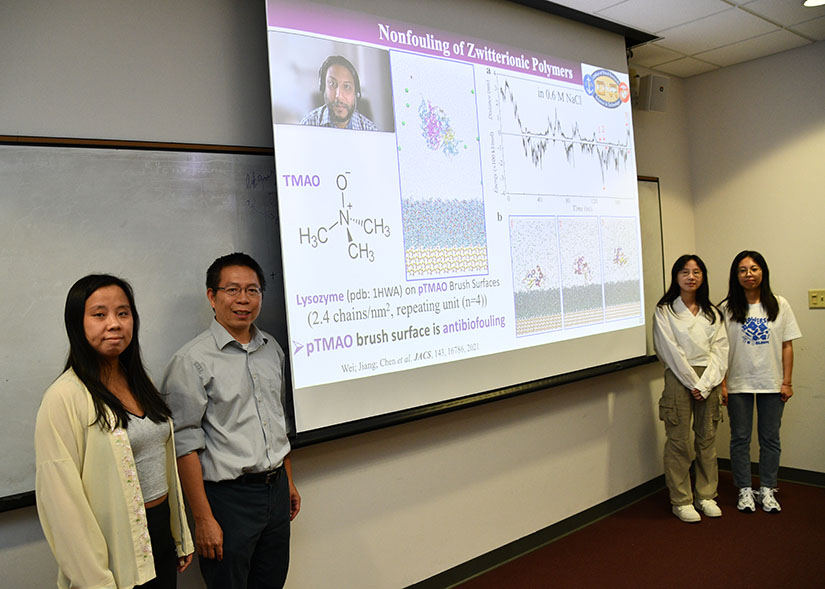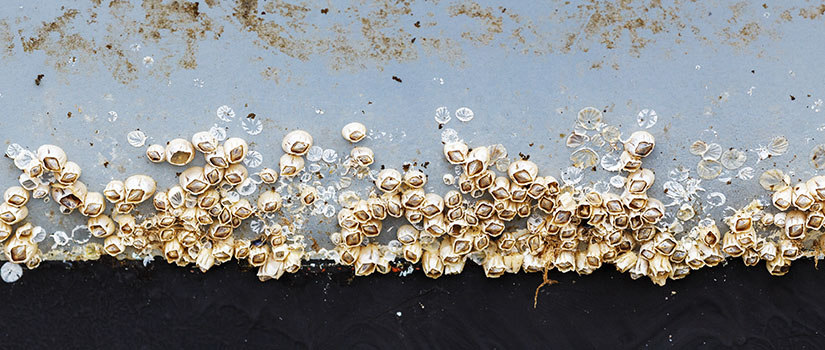The attachment of biomolecules and microorganisms onto ship hulls introduces marine biofouling. This poses problems to the U.S. Navy by increasing the hydrodynamic drag on vessels’ sailing and causes corrosion on metal surfaces.
To combat marine biofouling, new environmentally benign coating materials have become suitable for replacing traditional toxic materials. This past February, Chemical Engineering Associate Professor Tao Wei began a three-year, Office of Naval Research and Department of Defense (DoD)-funded research project that will examine using two new materials alongside advanced technology. This is the second part of a previous three-year project, which was successfully completed.
Wei has been studying the antibiofouling and fouling release mechanisms of new zwitterionic and amphiphilic materials using multiscale simulations combined with machine learning and 3D visualization technology. Zwitterionic polymers, which contain alternating positive and negatively charged components, have a small dipole moment and strong hydration that can resist absorption by marine biofoulers. Amphiphilic materials, which contain hydrophobic (non-mixed water) and hydrophilic (mixed with water) components, can provide fouling release functionalities.
Both zwitterionic and amphiphilic materials are biocompatible and ideal for coating, which is necessary for protecting naval vessels. Heavy metals such as lead and mercury were previously used to prevent biofouling; however, they are not biocompatible and contaminate sea water.
“If the surface is contaminated by these microorganisms, it causes corrosion, and increases friction and fuel consumption,” Wei says. “Today, we want to find more biocompatible coating materials to maximize the performance of naval vessels.”
According to Wei, the best method to combat biofouling is determined by a surface’s hydration and surface energy, which can be controlled by adjusting certain properties such as chemistry and charge distribution, and the mechanical properties that are correlated with crosslinked structures.
“You can imagine the zwitterionic polymer coating surfaces are covered by a condensed water layer with an ordered structure serving as an energy barrier to resist biofouler adsorption. This prevents microorganisms from coming to the surface. We are looking for the best surface design and molecular structure,” Wei says.
Wei adds that in alternating materials, amphiphilic polymers combine the mixed hydrophobic and hydrophilic components together.
“When a microorganism comes to the surface, the biofoulers cannot stay on the surface tightly,” Wei says. “When we put the hydrophobic and hydrophilic components together, the surface energy is so small that biofoulers can easily wash away.”
Besides the computer simulations, Wei will utilize machine learning and visualization to provide comprehensive insights on marine biofouling mitigation mechanisms. The computational work will rationalize experimental design of novel non-toxic, effective antibiofouling and fouling release materials for ship hull coatings.
“We have a format with the team for zwitterionic materials and amphiphilic surfaces. We will explain the physics and theory to design the molecule surface, while the experimental path will be done by our experimental collaborators at Cornell University and the University of Michigan,” Wei says.

Research Group (L-R): Xiaoxue Qin, Tao Wei, Ph.D., Jiahuiyu Fang, Shuting Zhang, Ph.D., Shuting Zhang, Ph.D. (on screen)
Wei’s group has published several peer-reviewed papers about this project and received two paper awards. Their Journal of the American Chemical Society paper ranks among the most cited publications from 2020 to 2021, and their Chemical Science paper was selected for the 2023 Chemical Science HOT Article collection. The project also provides education and training for two Ph.D. students, Xiaoxue Qin and Jiahuiyu Fan, a postdoctoral researcher, Shuting Zhang, Ph.D., and a scientist, Pranab Sarker, Ph.D., at the University of South Carolina.
By the end of the three-year project, Wei hopes that his work will lead to an experimental design of novel, non-toxic effective antibiofouling and fouling release materials for ship hull coatings.
“It holds great future relevance and impact on U.S. Navy and DoD capabilities,” Wei says.
